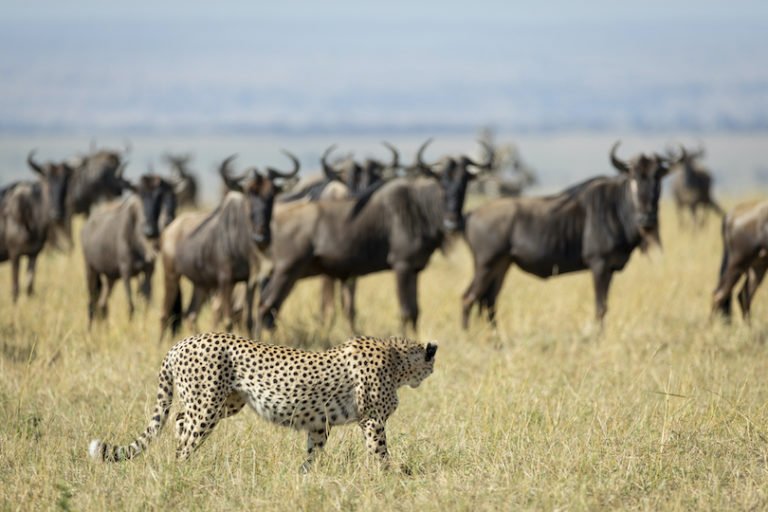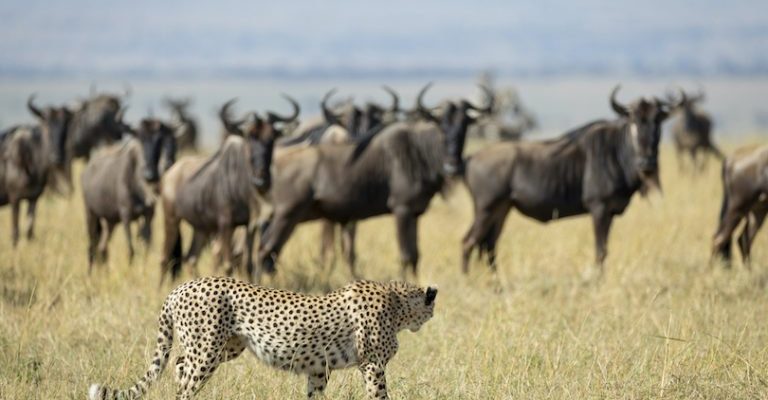
Wildebeests are herbivorous grazers that rely on the rich grasslands of Africa to sustain their large bodies. Their diet is not just a matter of munching on whatever they find. Instead, it involves strategic choices that help them stay healthy and survive in the wild. Understanding their eating habits gives us insight into their behavior, survival tactics, and the role they play in the ecosystem. So, let’s dive deeper into these fascinating animals and discover how they feast and fend off predators.
The Diet of the Wildebeest
Wildebeests primarily eat grass, but their selection is more nuanced than you might think. They favor short grasses over tall ones, particularly after the rainy season when nutrients are at their peak. This choice is like someone preferring a fresh salad over wilty greens—nourishing and much more enjoyable.
In addition to short grasses, wildebeests also consume leaves and shoots when necessary, especially during dry months when grass is scarce. They can be quite adaptable, shifting their focus based on availability. The **wildebeest’s unique digestive system** allows them to extract maximum nutrients from these grasses. They have a multi-chambered stomach that enables fermentation, making it easier to digest fibrous materials. This ability is crucial for surviving in harsh environments where food choices can be limited.
Interestingly, wildebeests are social eaters. They graze in large groups, which is an effective strategy for finding food. It’s like going to a buffet with friends; everyone can help each other spot the best dishes! When they graze together, they can cover large areas quickly and take advantage of the freshest grass.
Hunting Strategies: The Role of Predators
While wildebeests are herbivores and primarily focused on foraging, their existence is intricately tied to the predator-prey dynamic of the savanna. Predators like lions, hyenas, and crocodiles see wildebeests as a significant part of their diet. This relationship shapes how wildebeests behave and develop their strategies for survival.
One of the most fascinating hunting strategies is the **herd mentality**. Wildebeests are known to travel in large groups, which serves as a defense mechanism against predators. When a predator approaches, the herd tends to cluster together, creating confusion and making it harder for the predator to select a single target. Imagine a tight-knit group of friends huddled together to face a bully—there’s strength in numbers! This cooperative behavior greatly increases their chances of survival.
In addition, wildebeests are highly vigilant. They constantly scan their surroundings for potential threats. When they spot danger, they are quick to react, usually bolting in different directions to escape. This quick, unpredictable movement makes it challenging for predators to catch them.
The Great Migration: A Survival Strategy
Perhaps the most remarkable survival strategy of the wildebeest is the **Great Migration**. Every year, millions of wildebeests embark on a journey across the Serengeti and into Kenya’s Maasai Mara, searching for greener pastures. This annual movement is a response to the changing seasons and the availability of food and water.
During their migration, wildebeests face numerous challenges, including river crossings inhabited by crocodiles. You might wonder why they would take such risks. The answer is simple: the survival of the herd depends on finding the best grazing areas. Moving in a cycle ensures that they can replenish their energy and stay healthy throughout the year.
The migration is not just about survival; it’s also a spectacle of nature. The sheer size and determination of these herds create a breathtaking view. It’s a test of endurance and instinct that speaks to the heart of what it means to thrive in the wild.
How Wildebeests Contribute to the Ecosystem
Wildebeests play an essential role in the African ecosystem. Their grazing habits help control grass growth, which in turn supports a diverse range of plant and animal life. The grasslands thrive because of their natural foraging, creating an environment that benefits many species.
Moreover, wildebeests are crucial for nutrient cycling. As they graze, they excrete waste that fertilizes the soil. This process enhances the growth of new vegetation, showing how interconnected life is within the savanna. The presence of wildebeests attracts other herbivores, which rely on the same grasses, leading to a balanced ecosystem.
In essence, wildebeests are not just survivors; they are nurturers of their environment. Their migration and grazing create opportunities for other animals, creating a dynamic where life continues to thrive.
Adapting to Environmental Changes
As climate patterns shift, wildebeests are forced to adapt to new environmental challenges. For instance, prolonged droughts can significantly impact their food sources. During such times, wildebeests need to be even more resourceful in finding sustenance. They may roam farther and explore new territories to find the nourishment they need.
Climate change also affects their migratory patterns. With changing weather patterns, the timing of the Great Migration can shift, leading to potential mismatches in the availability of food and resources. This adaptability is critical for their survival, although it comes with risks.
Natural predators are also adapting. If lion populations grow in a specific area, for example, wildebeests may change their migratory route to avoid those areas. This constant dance of adaptation showcases the resilience of wildebeests and their vital place in the ecosystem.
Wildebeests are truly fascinating creatures that exemplify the intricate relationships within nature. Their diet, hunting strategies, and survival tactics reveal not just how they stay alive but how they contribute to the balance of the ecosystem. From their cooperative grazing to their awe-inspiring migrations, wildebeests showcase the strength found in community and adaptation.
By understanding these remarkable behaviors and the challenges they face, we gain a deeper appreciation for the natural world and the delicate balance that sustains life. Next time you think of these iconic animals, remember their role as both grazers and nurturers of their environment—a true testament to the resilience of nature.

